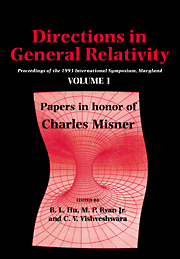 Directions in General Relativity
Directions in General Relativity Book contents
- Frontmatter
- Contents
- Contributors
- Symposium Program
- Papers from both Volumes Classified by Subject
- Preface
- Charles W. Misner: Insight and Discovery
- Remarks Concerning the Geometries of Gravity and Gauge Fields
- Gravity and Unification of Fundamental Interactions
- Minisuperspaces: Symmetries and Quantization
- Quantum Cosmology
- A Pictorial History of some Gravitational Instantons
- No Time Machines from Lightlike Sources in 2+1 Gravity
- Inhomogeneity and Anisotropy Generation in FRW Cosmologies
- Misner, Kinks and Black Holes
- The Quantum Mechanics of Closed Systems
- Cosmological Vacuum Phase Transitions
- Minisuperspace as a Quantum Open System
- Ricci Flow on Minisuperspaces and the Geometry-Topology Problem
- Classical and Quantum Dynamics of Black Hole Interiors
- Matter Time in Canonical Quantum Gravity
- The Isotropy and Homogeneity of the Universe
- Recent Advances in ADM Reduction
- Some Progress in Classical Canonical Gravity
- Harmonic Map Formulation of Colliding Electrovac Plane Waves
- Geometry, the Renormalization Group and Gravity
- An Example of Indeterminacy in the Time-Development of “Already Unified Field Theory”: A Collision between Electomagnetic Plane Waves
- Non-static Metrics of Hiscock-Gott Type
- Non-Standard Phase Space Variables, Quantization and Path-Integrals, or Little Ado about Much
- The Present Status of the Decaying Neutrino Theory
- Exploiting the Computer to Investigate Black Holes and Cosmic Censorship
- Misner Space as a Prototype for Almost Any Pathology
- Relativity and Rotation
- The First Law of Black Hole Mechanics
- Gravitational Radiation Antenna Observations
- The Back-Reaction is Never Negligible: Entropy of Black Holes and Radiation
- Toward a Thesis Topic
- Charles Misner: A Celebration of Memories
- Curriculum Vitae of C. W. Misner
- Ph. D. Theses supervised by C. W. Misner
- List of Publications of C. W. Misner
Some Progress in Classical Canonical Gravity
Published online by Cambridge University Press: 03 February 2010
- Frontmatter
- Contents
- Contributors
- Symposium Program
- Papers from both Volumes Classified by Subject
- Preface
- Charles W. Misner: Insight and Discovery
- Remarks Concerning the Geometries of Gravity and Gauge Fields
- Gravity and Unification of Fundamental Interactions
- Minisuperspaces: Symmetries and Quantization
- Quantum Cosmology
- A Pictorial History of some Gravitational Instantons
- No Time Machines from Lightlike Sources in 2+1 Gravity
- Inhomogeneity and Anisotropy Generation in FRW Cosmologies
- Misner, Kinks and Black Holes
- The Quantum Mechanics of Closed Systems
- Cosmological Vacuum Phase Transitions
- Minisuperspace as a Quantum Open System
- Ricci Flow on Minisuperspaces and the Geometry-Topology Problem
- Classical and Quantum Dynamics of Black Hole Interiors
- Matter Time in Canonical Quantum Gravity
- The Isotropy and Homogeneity of the Universe
- Recent Advances in ADM Reduction
- Some Progress in Classical Canonical Gravity
- Harmonic Map Formulation of Colliding Electrovac Plane Waves
- Geometry, the Renormalization Group and Gravity
- An Example of Indeterminacy in the Time-Development of “Already Unified Field Theory”: A Collision between Electomagnetic Plane Waves
- Non-static Metrics of Hiscock-Gott Type
- Non-Standard Phase Space Variables, Quantization and Path-Integrals, or Little Ado about Much
- The Present Status of the Decaying Neutrino Theory
- Exploiting the Computer to Investigate Black Holes and Cosmic Censorship
- Misner Space as a Prototype for Almost Any Pathology
- Relativity and Rotation
- The First Law of Black Hole Mechanics
- Gravitational Radiation Antenna Observations
- The Back-Reaction is Never Negligible: Entropy of Black Holes and Radiation
- Toward a Thesis Topic
- Charles Misner: A Celebration of Memories
- Curriculum Vitae of C. W. Misner
- Ph. D. Theses supervised by C. W. Misner
- List of Publications of C. W. Misner
Summary
INTRODUCTION
In China, I have learned, there is a valuable tradition: to appreciate and show great respect for one's teachers. Undoubtedly, the most successful method of teaching is by example. Certainly this was true in my case. Charles W. Misner was a pioneer in applying modern differential geometry (Misner 1964) especially differential forms (Misner and Wheeler 1957) to gravitational theory, in investigating the canonical Hamiltonian formulation of gravity, and in formulating suitable expressions for conserved quantities, in particular mass-energy (Arnowitt, Deser and Misner (ADM) 1962). I have, as this work indicates, at least to some extent, followed my teacher's directions.
The outline of this work is as follows. First, differential form methods are used to obtain a covariant Hamiltonian formulation for any gravitational theory. The Hamiltonian includes a covariant expression for the conserved quantities of an asymptotically flat or constant curvature space. Next the positive total energy test, a promising and appropriate theoretical test for alternate gravitational theories, is described. The final topic concerns application to Einstein gravity of new rotational gauge conditions and their associated special orthonormal frames. These frames provide a good localization of energy and parameterization of solutions.
COVARIANT HAMILTONIAN FORMALISM
There are significant benefits in the canonical Hamiltonian formulation of a theory, in particular the identification of constraints, gauges, degrees of freedom and conserved quantities (Isenberg and Nester 1980), however the usual approach (e.g., in Misner, Thorne and Wheeler (MTW) 1973 and ADM 1962) exacts a heavy price: the loss of manifest 4-covariance. Differential form techniques can be used to largely avoid this cost (Nester 1984).
Information
- Type
- Chapter
- Information
- Directions in General RelativityProceedings of the 1993 International Symposium, Maryland: Papers in Honor of Charles Misner, pp. 245 - 260Publisher: Cambridge University PressPrint publication year: 1993
Accessibility standard: Unknown
- 3
- Cited by